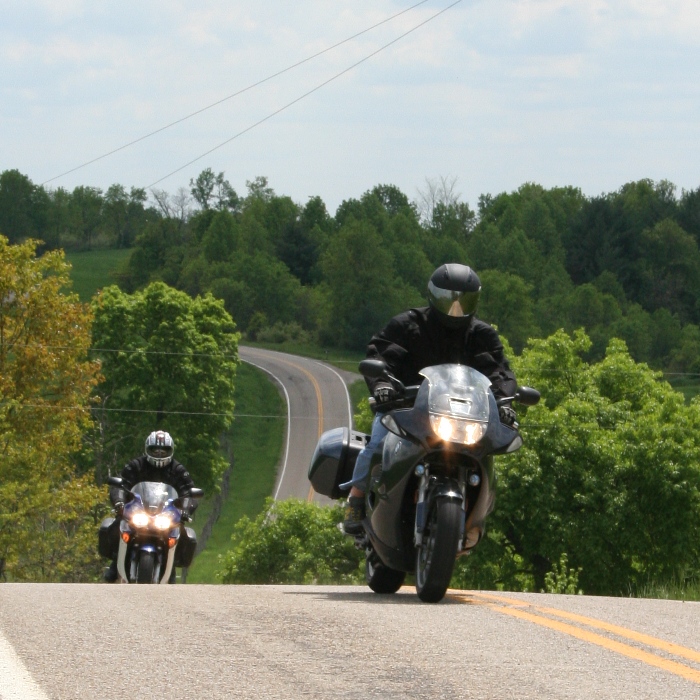
The only thing better than a motorcycle trip is a well planned motorcycle trip.
For many of us in northern climes, this is the time of year we spend looking longingly at maps and imagining all the places we’ll go as soon as the weather breaks. If I’d actually done all the trips I’ve dreamed of doing on some dreary February evening, I’d be in the million-mile club and would have worn out several more motorcycles.
Reality is usually different. Family responsibilities and limited time off from work keep most of us from fulfilling all those off-season fantasies. That just means that we need to travel smart to make the most of our time on the road. Based on my years of motorcycle travel, here are two dozen tips for smarter touring, divided into before, during and after categories:
Before you go
Check the list. Keeping a checklist of things to take on tour greatly reduces the odds of finding yourself 500 miles down the road and desperately needing something that’s back home in the garage. If you’re like me, you may have two lists: one for trips that involve camping, and another simpler one for when sleeping indoors.
Light is right. Packing light makes life easier: You spend less time packing and unpacking at the beginning and end of each day, your motorcycle handles better and it’s easier to find the things you need when there’s less to sort through. There’s truth in the old traveler’s saying of “take half as much clothes and twice as much money as you think you’ll need.” For riders, part of the key to that is to…
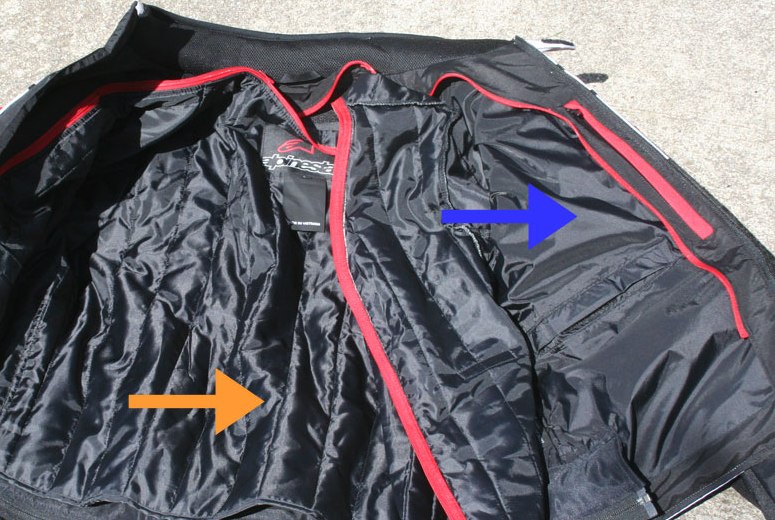
Today’s motorcycle gear offers versatility, such as this jacket with a built-in waterproof layer (blue arrow), removable thermal layer (orange arrow) and vents for cooling.
Choose gear for its versatility. Today’s motorcycle gear is fantastic. One jacket can take you from zipped-up, liner-in warmth on a drizzly, 50-degree morning, to liner-out, vents-open breezy on a 90-degree afternoon. On a budget? For summer travel, a mesh jacket combined with a rain suit to put on over top and a sweatshirt underneath is an inexpensive combo to prepare you for wet, dry, hot or cool.
Test pack. Unless you’re taking exactly the same things on exactly the same bike as your last trip (and that one went well), pack everything on your motorcycle well before departure to make sure it fits and attaches securely.
Adjust your suspension. Especially if you are traveling with a passenger and you’ve added a lot of weight with luggage, check the sag on the suspension. When you (and passenger, if there is one) are sitting on the loaded bike, you should be using up about 30 percent of the suspension travel. If the bike is sinking lower than that, increase the preload.
Test new gear. Taking delivery of a brand new pair of boots, gloves or other gear the night before leaving on a long trip is a good way to risk discomfort. Plan ahead so you can take some time to get used to, and break in, new gear before you spend hours and days with it on the road.
Be prepared for bonehead moves. Maybe you never do something stupid or make a mistake. If so, skip ahead. For the rest of us, having a spare key well hidden and securely attached can save you a lot of hassles and expense. I know, some will say don’t do it, for fear of theft. In a lifetime of traveling, I’ve had zero bikes stolen with a spare key and one case in which the spare saved the day. You make your call and take your chances.
Test your tool kit. Use your on-bike tool kit to check fasteners for your pre-trip check and you’ll find out what you’re missing. Also, try doing routine maintenance and repairs at home with only the tools you carry on your bike. That way, you’ll know you can handle minor issues on the road.
Don’t underestimate wear and tear. Parts like tires, brake pads and drive chains wear out fastest at the end of their lives. When in doubt, replacing them before you leave reduces your chances of a flat tire or the likelihood you’ll waste valuable traveling time sitting at a dealership waiting for the technician to install a new chain for you.
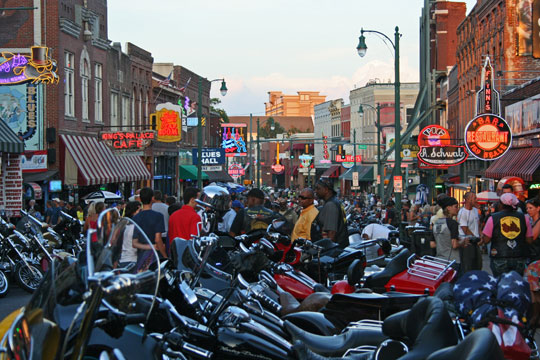
Where are you dreaming of going this summer?
Be prepared for flats. Flat tires happen. If you have tubeless tires, a small repair kit and pump take up little space and can get you down the road to find a more permanent solution. Tube tires are more complicated, but roadside repairs are still possible. I’m surprised how many riders have no plan for dealing with deflation.
Have a backup plan. When the tool kit and tire repair kit aren’t enough, you need a Plan B. Roadside assistance plans are more readily available than ever before, from membership groups, insurance companies and other sources.
Map up. If you’re traveling off the beaten path and you plan to use your smartphone for navigation assistance, download maps in advance for remote areas where you may not have cell service. Your phone’s GPS will still locate you, but without a cell tower in range, your phone won’t be able to download a map to show your position. Downloading maps will also decrease your data usage. If you’re analog and still using paper maps, then disregard and please follow proper folding technique.
The exception to packing light. Of course you have to pack essentials such as medications, a spare pair of eyeglasses, if you’re blind without them, etc. But beyond that, everybody has something that’s critical to happiness on the road, whether it’s a sheepskin seat cover, the right music to listen to, or whatever. For me, ear plugs and the right gloves are essential for comfort, so I’ll always take extra ear plugs and two or three pairs of gloves to suit different conditions. If you’re not comfortable, you won’t have as much fun and won’t have the concentration needed to be as safe as you can be.
Prepare your body. You know you need to prep your bike for a trip. What about prepping yourself? Regular cardiovascular workouts will increase your stamina and targeted weight training helps you avoid tired muscles at the end of a long day’s ride. But there’s another less obvious benefit of fitness: If you’re less fatigued physically, you’ll be sharper mentally, and therefore more alert and safer on the road.
On the road
Be realistic about mileage. It’s tempting to try to cram everything you want to do into one trip, but unless you’re competing in the Iron Butt Rally, your motorcycle tour is a vacation, not an endurance run. If you pound out high mileage day after day, you’ll probably arrive home tired, not rejuvenated, and your memories will be one big 65 mph blur. On a long, multi-day trip, plan a day of downtime for resting up, attending to little issues with the bike, doing laundry, etc.
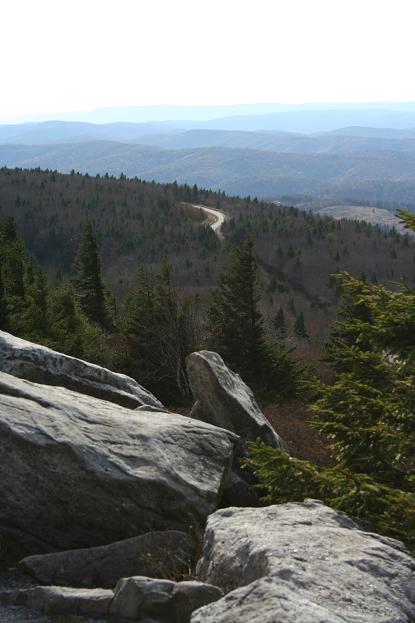
The road to the peak of Spruce Knob, highest point in West Virginia.
Match mileage to terrain. When planning your itinerary, consider the kind of riding. I’ve ridden 550-mile interstate highway days and 250-mile mountain road days that were both a solid eight hours of riding. If I’m enjoying my favorite roads in eastern West Virginia, for example, I know that 200 miles is a lot of riding for one day.
Don’t skip the pre-flight check. It’s a beautiful morning and you’re eager to ride, but far from home is not the place to forego daily safety checks. In fact, with extra gear packed on the bike, you have more things to check than just tire pressures, chain tension, etc. A minute spent making sure everything is cinched down tightly can save you hours of headaches later.
Remember: you ain’t from around here. At home, on your daily commute, you know where to watch for the frantic merge caused by a poorly designed exit ramp or the rural curve that always has gravel kicked up on it. Away from home, vigilance must stay high to balance the lack of local knowledge. Sure, you want to relax and enjoy the sights, but you still have to maintain your usual level of alertness — or better.
Time management: avoid crowds. Ultimately, time is the only thing you can’t buy more of, so not wasting it is crucial. Having more time allows you to choose a scenic and curvy route instead of the interstate or linger with an interesting person or a beautiful sight encountered unexpectedly, and still make it home when duty calls. One way not to waste time is to avoid crowds. Planning to end your day near a big city? Call it a night on the far side of the metropolis, so in the morning you’ll be leaving the rush hour hordes behind instead of jockeying with them for highway space. Try to time your passage through urban areas in off hours.
Time management: eating. Avoid the breakfast and lunch rushes by putting in 100 miles before breakfast and calling it brunch. Better yet, pack healthy snacks and have a roadside picnic, instead. You’ll spend less money, eat better than if you hit fast food joints, and not lose a precious minute waiting for a server in a restaurant.
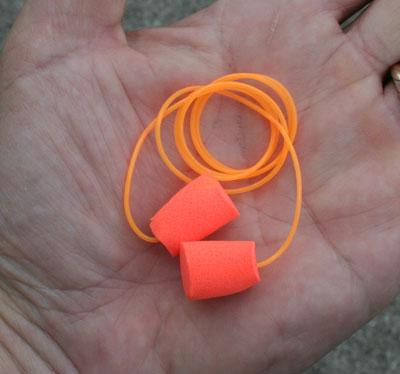
Ear plugs: a small thing that makes a big difference on long rides.
Wear earplugs. If you’re not already wearing ear plugs on any ride over 20 minutes, start now. Reducing wind noise will significantly diminish fatigue and help you maintain concentration on your ride now, and will save your hearing in the long run.
Stay hydrated. It’s the most common tip in the tourbook for a good reason. Get dehydrated and you’ll end the day mentally fuzzy with a headache, or worse. It’s not just an issue when you’re dripping with sweat, either. Cold, dry air robs moisture in less noticeable ways. If you don’t like stopping for water breaks, consider a hydration backpack.
Be flexible. Follow your whims, don’t be afraid to change plans, and revel in the unexpected discoveries of travel. The greatest memories are often unplanned.
Once you’re home
Revise your checklist. We start with one, we end with one. Look for non-emergency items you didn’t use and cross them off the list for next time. Any good checklist is a living, evolving document.
